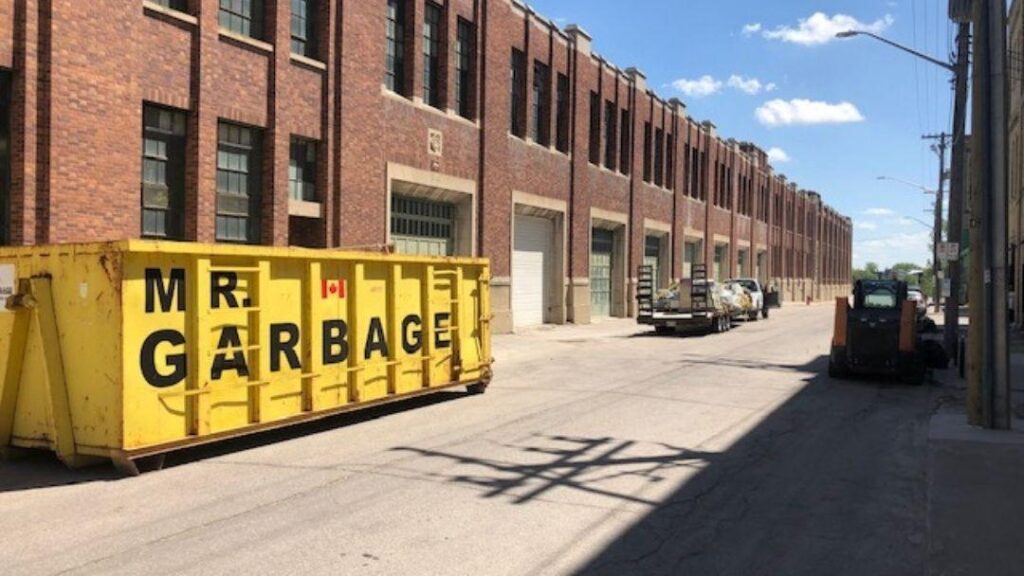If you’re working on a renovation, basement cleanout, or landscaping job in eastern Winnipeg, a 30-yard roll-off dumpster is a common, practical choice. This guide explains why a 30-yard container is popular for residential projects, how deliveries and truck access work in older east-side neighbourhoods, what you may not put in the bin, and how to maximize recycling and avoid permit headaches.
I’ll include real local references (4R depots and City of Winnipeg permit guidance), practical site-prep steps, and examples of how homeowners use 30-yard roll-offs. I’ll also show where Mr. Garbage fits in; their local delivery, permit coordination, and routing to recycling partners can make a big difference on delivery day.
What is a 30-yard roll-off dumpster in Eastern Winnipeg, and why choose it?
A 30-yard roll-off dumpster in eastern Winnipeg is an open-top roll-off container sized to hold large volumes of household and construction debris. For many eastern Winnipeg homeowners, it’s a good balance of capacity and driveway fit: big enough to hold multi-room renovation waste or estate cleanouts, but compact enough to fit most driveways and laneways when the drop point is planned properly.
Why homeowners pick a 30-yard container:
- Holds a large volume of mixed waste without multiple trips to the transfer station.
- Works well for whole-room remodels, major cleanouts, and light demolition.
- Fits in many residential driveways if the approach and clearance are checked in advance. Mr. Garbage
If you’re searching “dumpster roll off near me eastern winnipeg,” you’ll find local providers who deliver 30-yard bins and advise on access, permits, and acceptable materials.
Delivery and truck access (what to plan)
Delivery logistics are the most common reason a booked bin becomes a problem on day one. Plan these elements, and your delivery will be smooth.
Truck approach and space
- Roll-off trucks are long. Ensure there’s a straight or manageable turning path from the street to your driveway.
- Measure overhead clearance for tree branches, eaves, or power lines. Drivers need vertical space to tip and roll the bin.
- Confirm driveway surface and load bearing, soft lawns, new asphalt, or weak pavers may be damaged without protection under the bin. Ask your hauler about driveway protection. Mr. Garbage
Best drop-point tips
- Keep the bin fully on private property when possible to avoid needing a street permit.
- If curb or boulevard placement is unavoidable, plan for a street-use permit through Public Works (the City has guidance on Use of Street permits). City of Winnipeg
- Photograph the approach and send pictures to your hauler; many providers (including Mr. Garbage) will confirm delivery feasibility from photos and recommend alternate placement if needed. Mr. Garbage
What to put in a 30-yard roll-off dumpster, Eastern Winnipeg: accepted and prohibited items
Knowing what belongs in the dumpster keeps your load from being rejected at the landfill or transfer station.
Commonly accepted materials
- Non-hazardous construction debris: drywall, wood framing, cabinets, flooring (clean).
- Bulky household items: furniture, mattresses (donate first if items are reusable).
- Mixed household renovation waste is produced during a cleanout or remodel.
Items that need special handling
- Electronics and many batteries must go to certified e-waste facilities or City 4R Depots (Brady, Pacific, Panet). Don’t rely on a general roll-off for e-waste. winnipeg.ca
- Household hazardous waste (paints, solvents, pesticides) is accepted at 4R depots under special programs; avoid mixing these into the roll-off. winnipeg.ca
- Appliances with refrigerant (fridges, freezers, AC units) require refrigerant recovery by certified techs before disposal.
- Asbestos, contaminated soils, and other regulated hazardous materials require licensed abatement and special disposal; never put them into a standard roll-off dumpster. winnipeg.ca
Always declare anything suspect or heavy to your hauler when you book. They’ll tell you if a material needs different handling.
Permits, street placement, and City rules in Eastern Winnipeg
Permits are a local, concrete issue, especially in denser, older parts of eastern Winnipeg.
When a permit is required
If any part of your 30-yard bin will sit on public property (sidewalk, boulevard, or street), City of Winnipeg rules generally require a Use of Street or similar permit. If the bin fits entirely on private property (driveway or private lane), a permit is often unnecessary. That said, local bylaws and traffic rules can vary; confirm with the City or your hauler. City of Winnipeg
Hauler helps with permits.
Good local haulers (Mr. Garbage among them) will:
- Tell you when a permit is needed.
- Help you arrange the permit or advise on an alternative placement to avoid it.
- Manage signage and timing to comply with Traffic Management conditions when public space must be used. Mr. Garbage
As a rule, planning placement early permits applications and approvals to take time, and a late permit surprise can delay your job.
Recycling, diversion, and 4R depot options for eastern Winnipeg projects
A smarter load is a greener load. Separating materials reduces landfill use and often saves headaches at the transfer station.
Use 4R depots for special streams.
Winnipeg’s 4R Depots accept electronics, batteries, household hazardous waste, and other items that shouldn’t go into a roll-off. Use depots for these streams rather than risking contamination of your roll-off load. Depot locations and accepted items are listed on the City site and in depot guides. winnipeg.ca
On-site separation tips for roll-off dumpsters in Eastern Winnipeg
- Pull out metals, clean wood, and cardboard for recycling before loading the general bin.
- Donate reusable furniture and appliances — many local charities accept donated items in good condition.
- Keep hazardous products and electronics separate and plan a depot run early in your project timeline.
National data shows residential sources are a major part of diversion efforts; separating streams at the source helps Winnipeg meet diversion goals and reduces the volume sent to landfill. Statistics Canada
Common problems homeowners face with roll off dumpsters — and how to avoid them
A little planning removes most surprises.
Top issues and simple fixes
- Delivery blocked by parked cars or tight turns. Fix: clear the approach and give the driver a direct line of sight.
- Overweight or prohibited items discovered on site. Fix: declare heavy materials (concrete, tile, soil) at booking and remove banned items before pickup.
- Damage to the driveway or lawn. Fix: protect the surface with plywood or mats under the bin; request driver placement to minimize movement.
- Unplanned permit needs. Fix: confirm placement during booking and let the hauler advise on permitting early. Mr. Garbage
Ask the hauler for a delivery checklist — reputable local companies provide one and walk you through it.
How Mr. Garbage helps homeowners rent a 30-yard roll-off dumpster in Eastern Winnipeg
Using a local provider simplifies logistics and improves diversion outcomes.
Roll off dumpster services Mr. Garbage offers in Eastern Winnipeg.
- Site assessment and delivery planning tailored to eastern Winnipeg streets and lanes.
- Permit coordination for street placements when needed.
- Guidance on separating recyclables and routing special streams (e-waste, hazardous waste) to 4R depots.
- Staged pickups for multi-phase projects and documentation of disposal routing on request. Mr. Garbage
Local knowledge matters. A hauler familiar with eastern neighbourhoods can avoid narrow lanes, low bridges, and other access issues that might surprise an out-of-town provider.
Real homeowner examples
Kitchen and two-room renovation
Homeowner uses a 30-yard roll-off to collect cabinets, subfloor, and drywall. Crew separates metal and cardboard on site for recycling. Bin keeps the driveway tidy and avoids multiple trips to the transfer station.
Estate cleanout and staging
A 30-yard container holds furniture, boxes, and soft goods. Reusable furniture is donated; electronics and hazardous cleaners are taken to the 4R depot. The single bin removes most waste in one visit and speeds the staging process.
Major landscaping and deck removal
Yard debris and decking material fit efficiently in the 30-yard roll-off; heavy soil and rocks are declared ahead of time and handled per facility rules to avoid weight penalties.
These examples reflect typical eastern Winnipeg projects and show why the 30-yard size often hits the sweet spot for capacity and driveway fit.
Is a 30-yard roll-off dumpster in Eastern Winnipeg right for you?
Use this quick guide before you call:
- Are you doing a multi-room renovation, whole-house cleanout, or demolition? If yes, a 30-yard bin is often suitable.
- Can your driveway or delivery area accommodate a long roll-off truck approach? Measure length and width.
- Will the bin sit fully on private property, or will you need a street permit? Plan accordingly. City of Winnipeg
- Are there heavy materials (concrete, tile, soil)? Declare them to your hauler in advance.
- Can you separate metals, clean wood, cardboard, and e-waste for recycling or depot drop-off?
If most answers point to “yes”, call a local hauler for a site assessment and delivery plan.
Final safety, insurance, and record-keeping notes
A responsible cleanup includes paperwork.
- Keep disposal receipts and routing documentation — they’re useful for resale disclosures and insurance claims.
- Use licensed contractors for refrigerant recovery and asbestos removal; they provide the legal documentation you’ll need.
- Protect neighbours and pedestrians: position the bin to keep sidewalks clear and secure loose debris to prevent windblown litter.
Documentation and careful handling protect you and your property beyond the cleanup day.
Conclusion
A 30-yard roll-off dumpster in eastern Winnipeg is a versatile option for homeowners handling renovations, major cleanouts, and landscaping projects. The keys to a smooth rental are planning truck access, confirming placement and permit needs, separating recyclables and special streams, and communicating heavy or hazardous materials to your hauler.
Mr. Garbage helps eastern Winnipeg homeowners from the first site check through final pickup: delivery planning, permit coordination, staged pickups, and routing to local 4R depots and recyclers. If you want a fast recommendation for your property, reach out to Mr. Garbage. They’ll match the right roll-off, advise on depot runs for e-waste and hazardous items, and handle delivery so cleanup becomes the easiest part of your project.
Ready to book a 30-yard roll-off dumpster in eastern Winnipeg? Contact Mr. Garbage for a site assessment and delivery plan tailored to your job.
Frequently Asked Questions (FAQs)
Q1: What is a 30-yard roll-off dumpster best for?
A1: A 30-yard roll-off dumpster is ideal for multi-room renovations, major cleanouts, and projects where you want one container to remove most debris without frequent trips to the transfer station.
Q2: Do I need a permit to place a 30-yard roll-off dumpster on the street in eastern Winnipeg?
A2: If any part of the bin sits on public property (boulevard, sidewalk, or street), the City of Winnipeg usually requires a Use of Street permit; bins on private property typically avoid this permit requirement.
Q3: Can I put electronics and paint in my 30-yard roll-off dumpster?
A3: No. Electronics and household hazardous waste (paint, solvents) should go to City 4R depots or certified processors; don’t mix them into a general roll-off load.
Q4: How do I prepare my driveway for a 30-yard roll-off dumpster delivery?
A4: Clear the approach, measure length and overhead clearance, protect soft surfaces with plywood if needed, and remove parked cars from the route. Send photos to your hauler for confirmation.
Q5: How can I increase recycling when using a roll-off dumpster?
A5: Separate metals, clean wood and cardboard before loading; drop e-waste and hazardous items at 4R depots; and donate reusable items to local charities to divert material from landfill.

